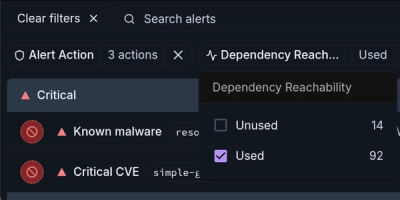
Product
Introducing Module Reachability: Focus on the Vulnerabilities That Matter
Module Reachability filters out unreachable CVEs so you can focus on vulnerabilities that actually matter to your application.
@loopback/authentication
Advanced tools
A LoopBack component for authentication support.
This is a reference implementation showing how to implement an authentication component, it is not production ready.
The component demonstrates how to leverage Passport module and extension points provided by LoopBack Next to implement an authentication layer.
npm install --save @loopback/authentication
Start by decorating your controller methods with @authenticate to require
the request to be authenticated.
// controllers/my-controller.ts
import {UserProfile, authenticate, AuthenticationBindings} from '@loopback/authentication';
import {inject} from '@loopback/core';
import {get} from '@loopback/rest';
export class MyController {
constructor(@inject(AuthenticationBindings.CURRENT_USER) private user: UserProfile) {}
@authenticate('BasicStrategy')
@get('/whoAmI')
whoAmI() {
return this.user.id;
}
}
Next, implement a Strategy provider to map strategy names specified
in @authenticate decorators into Passport Strategy instances.
Remember to install passport, passport-http, @types/passport, and
@types/passport-http modules beforehand.
// providers/auth-strategy.ts
import {
inject,
Provider,
ValueOrPromise,
} from '@loopback/context';
import {
AuthenticationBindings,
AuthenticationMetadata,
} from '@loopback/authentication';
import {Strategy} from 'passport';
import {BasicStrategy} from 'passport-http';
export class MyAuthStrategyProvider implements Provider<Strategy | undefined> {
constructor(
@inject(AuthenticationBindings.METADATA)
private metadata: AuthenticationMetadata,
) {}
value() : ValueOrPromise<Strategy | undefined> {
// The function was not decorated, so we shouldn't attempt authentication
if (!this.metadata) {
return undefined;
}
const name = this.metadata.strategy;
if (name === 'BasicStrategy') {
return new BasicStrategy(this.verify);
} else {
return Promise.reject(`The strategy ${name} is not available.`);
}
}
verify(username: string, password: string, cb: Function) {
// find user by name & password
// call cb(null, false) when user not found
// call cb(null, userProfile) when user is authenticated
}
}
In order to perform authentication, we need to implement a custom Sequence invoking the authentication at the right time during the request handling.
// sequence.ts
import {
inject,
} from '@loopback/core';
import {
FindRoute,
InvokeMethod,
ParsedRequest,
ParseParams,
Reject,
Send,
ServerResponse,
SequenceHandler,
RestBindings,
} from '@loopback/rest';
import {
AuthenticateFn,
AuthenticationBindings,
} from '@loopback/authentication';
const SequenceActions = RestBindings.SequenceActions;
export class MySequence implements SequenceHandler {
constructor(
@inject(SequenceActions.FIND_ROUTE) protected findRoute: FindRoute,
@inject(SequenceActions.PARSE_PARAMS) protected parseParams: ParseParams,
@inject(SequenceActions.INVOKE_METHOD) protected invoke: InvokeMethod,
@inject(SequenceActions.SEND) protected send: Send,
@inject(SequenceActions.REJECT) protected reject: Reject,
@inject(AuthenticationBindings.AUTH_ACTION)
protected authenticateRequest: AuthenticateFn,
) {}
async handle(req: ParsedRequest, res: ServerResponse) {
try {
const route = this.findRoute(req);
// This is the important line added to the default sequence implementation
await this.authenticateRequest(req);
const args = await this.parseParams(req, route);
const result = await this.invoke(route, args);
this.send(res, result);
} catch (err) {
this.reject(res, req, err);
}
}
}
Finally, put it all together in your application class:
import {
AuthenticationComponent,
AuthenticationBindings,
} from '@loopback/authentication';
import {RestApplication, RestServer} from '@loopback/rest';
import {MyAuthStrategyProvider} from './providers/auth-strategy';
import {MyController} from './controllers/my-controller';
import {MySequence} from './sequence';
class MyApp extends RestApplication {
constructor() {
super();
this.component(AuthenticationComponent);
this
.bind(AuthenticationBindings.STRATEGY)
.toProvider(MyAuthStrategyProvider);
this.sequence(MySequence);
this.controller(MyController);
}
async start() {
await super.start();
const server = await this.getServer(RestServer);
console.log(`REST server running on port: ${server.getSync('rest.port')}`);
}
}
You can try your authentication component by using your favourite REST client
and by setting the authorization header. Here is an example of what your
request might look like using curl:
curl -X GET \
http://localhost:3000/whoami \
-H 'authorization: Basic Zm9vOmJhcg=='
For more info about passport, see passport.js.
run npm test from the root folder.
See all contributors.
MIT
FAQs
A LoopBack component for authentication support.
The npm package @loopback/authentication receives a total of 6,119 weekly downloads. As such, @loopback/authentication popularity was classified as popular.
We found that @loopback/authentication demonstrated a healthy version release cadence and project activity because the last version was released less than a year ago. It has 7 open source maintainers collaborating on the project.
Did you know?

Socket for GitHub automatically highlights issues in each pull request and monitors the health of all your open source dependencies. Discover the contents of your packages and block harmful activity before you install or update your dependencies.

Product
Module Reachability filters out unreachable CVEs so you can focus on vulnerabilities that actually matter to your application.

Company News
Socket is bringing best-in-class reachability analysis into the platform — cutting false positives, accelerating triage, and cementing our place as the leader in software supply chain security.

Product
Socket is introducing a new way to organize repositories and apply repository-specific security policies.